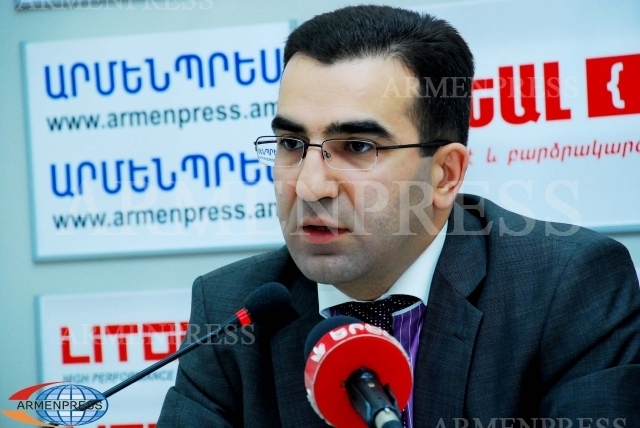Armenia's Deputy Economy Minister clarifies Armenia's foreign trade indicators
 19:07, 21 February 2015
19:07, 21 February 2015YEREVAN, 21 FEBRUARY, ARMENPRESS. The National Statistical Service of the Republic of Armenia has released the statistics for the month of January of 2015. According to the statistics, compared to January 2014, the overall trade turnover in Armenia reduced by 30.4%, while exports rose by 21.9%.
Touching upon the statistics on Armenia’s foreign trade turnover in an interview with “Armenpress”, First Deputy Minister of Economy of the Republic of Armenia Garegin Melkonyan mentioned that there are several factors that need to be taken into consideration in order to make sure the interpretations are correct. “The first factor that I would like to emphasize is the methodology of the statistics. As we all know, Armenia acceded to the Eurasian Economic Union in January 2015, and accession has a certain impact on the statistics on imports and exports of the member states. The announced figures officially indicated as a notification, apparently in regard to the trade section that related to the trade turnover between Armenia and other member states of the Eurasian Economic Union have to be specified, and perhaps not all the trade has been included. This means that if prior to 2 January 2015 Armenia exported products to Russia, Kazakhstan or Belarus, that is clearly seen as export from Armenia to those countries since there were customs formulations on the border, and that was very clearly shown in the statistics. It was the same with imports. However, starting from January 2nd when Armenia joined the Eurasian Economic Union, there are no more customs formulations for trade with those countries since Armenia is in the same economic zone. This means that the product is formulated as transit (via Georgia) on the border, is moved to, say, Russia, and the free circulation continues there. Therefore, in this case there will be a certain amount of products for import and export, and that will lead to changes in the statistics. As to how many changes will be made, we can judge by the indicators of last year, according to which Armenia’s trade turnover with Russia made up 24 percent of Armenia’s entire trade turnover. This is quite a serious indicator, and the overall impact of this is of essential significance for the statistics. The methodology of calculations of turnover between Armenia and other member states of the Eurasian Economic Union can play an important role here. Are those figures included completely or not? I believe there is a problem with specification here,” Melkonyan underlined.
The Deputy Minister emphasized the fact that the major shifts in the global market in December 2014 had a significant impact on the statistics, particularly the major shifts recorded in the Russian financial market. “As you know, the prices of imported products in the Russian ruble go up as a result of the fall of the Ruble exchange rate, and we’re in a situation where the exporters who had signed contracts expressed in dollars have created an unfavorable situation for Russian importers because the price of the imported products is quite high in the local market. The contracts concluded in Rubles created an unfavorable situation for Armenia’s local exporters, and all this is a matter of time and needs to be specified,” Melkonyan informed.
The Deputy Minister of Economy of the Republic of Armenia says the third factor is that some Armenian businesspeople are waiting due to Armenia’s accession to the EEU. “This particularly refers to the procedures, instruments and formulations. The differences between the statistics of this January and last January can be explained by this situation because, if you recall, before mid-January, many Armenian businesspeople were trying to understand what had changed in Armenia following the country’s accession to the Eurasian Economic Union,” the Deputy Minister highlighted.
Melkonyan mentioned another factor that had an impact on the statistics. “Businesspeople knew in advance that there were certain changes in the customs rates for imports and exports. They had imported some products and had accumulated resources in December,” he said.
Garegin Melkonyan mentioned that the price changes recorded in the global market in November-December of last year were also a factor that had an impact on the statistics on foreign trade turnover. “As we know, the raw materials of copper, molybdenum and gold make up a large part of Armenia’s exports, and the fall of prices of these products in the global market would be expressed in Armenia’s export indicators at least in terms of prices, even if the amounts had remained the same,” Melkonyan informed.
According to the Deputy Minister, the fact that there were many non-working days in January can also have a certain impact on the statistics.





















